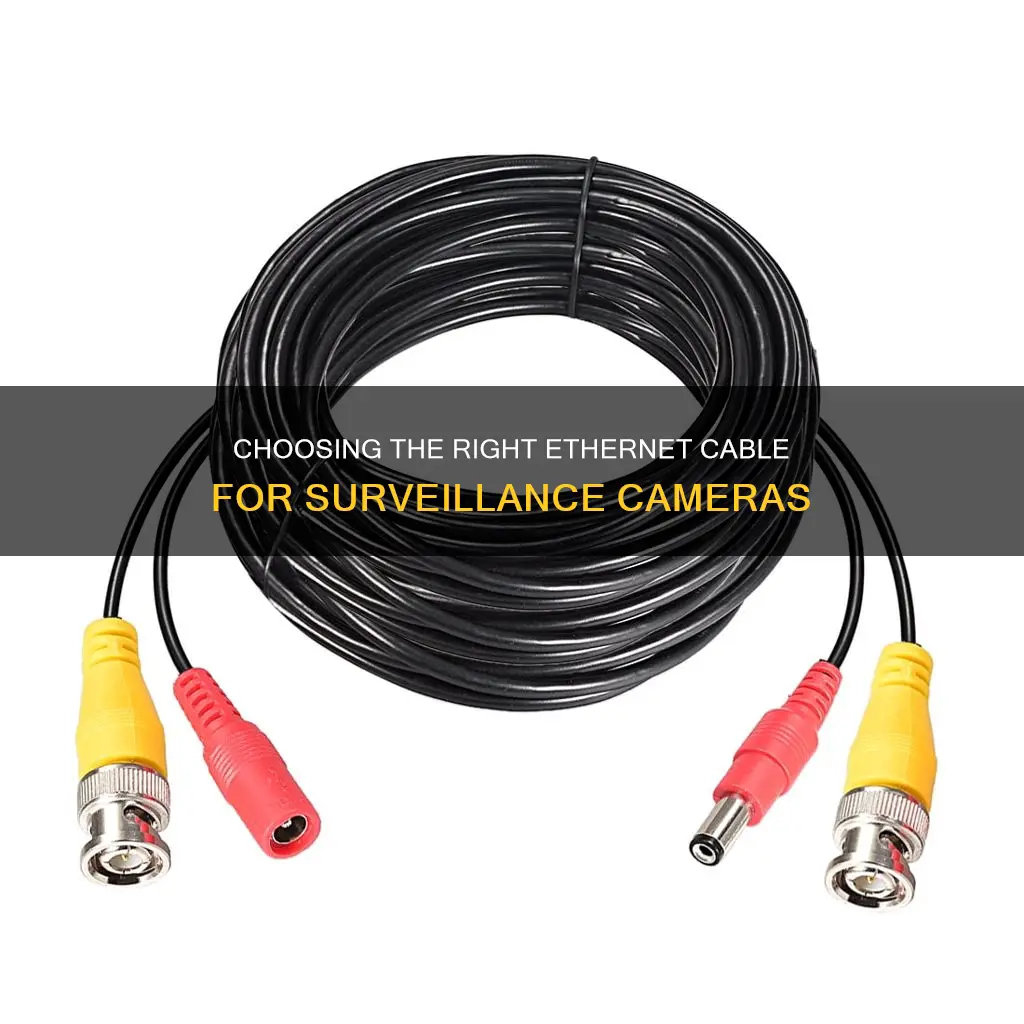
Choosing the right ethernet cable for your surveillance camera is crucial to ensure a stable connection and effective data transmission. The two main types of security cameras are IP cameras and analog cameras, and the selection of the appropriate ethernet cable depends on the specific camera system being used. IP cameras transmit video data over an internet connection and can be powered by Power over Ethernet (PoE), while analog cameras record images and send the signal through a coaxial cable to a DVR for conversion and storage. Ethernet cables are suitable for both types of cameras, offering advantages such as fast and reliable connections, thin and flexible designs, versatility, and cost-effectiveness. The recommended ethernet cables for security cameras include Cat5e and Cat6, which provide sufficient bandwidth and speed for high-resolution cameras.
| Characteristics | Values |
|---|---|
| Cable Type | Cat5, Cat5e, Cat6, Cat6a, Cat7 |
| Max Transmission Speed (at 100m) | 10,000 Mbps / 10 Gbps |
| Recommended Cable Type for Security Cameras | Cat5e and Cat6 |
| Cable Function | Connects IP security cameras to the network and provides power via PoE |
| Cable Benefits | Minimises lag, reduces camera outages, cheaper than RG-59 Siamese cables |
| Cable Use Case | IP security cameras and analog security cameras |
What You'll Learn

IP vs. Analog Cameras
IP cameras and analog cameras are two types of surveillance cameras with distinct features and capabilities. Here is a detailed comparison between the two:
IP Cameras
IP (Internet Protocol) cameras record data and images digitally and store them on a hard drive or in cloud storage. They can connect directly to the internet, allowing for wireless data transmission and remote viewing of footage. IP cameras offer superior image quality and a wider field of view compared to analog cameras. They also have advanced features such as motion detection, object tracking, and video analytics, which can flag specific events and alert security personnel. IP cameras only require a single cable for power and data transmission, making them easier to install and reducing the amount of cabling needed. They are also scalable and can be integrated with other applications as part of a smart building strategy. However, IP cameras may have higher initial setup costs and require more storage space due to larger file sizes.
Analog Cameras
Analog cameras transmit data and footage through physical means, typically over coaxial cables, to a Digital Video Recorder (DVR) for storage. They tend to be simpler and more cost-effective, especially for smaller areas or businesses with limited budgets. Analog cameras have lower image quality and frame rates, making them less ideal for areas with high motion or detail requirements. They may also require more cameras to cover the same area as an IP camera. Additionally, analog cameras lack encryption, making them more susceptible to security breaches. However, analog cameras have improved over time, with high-definition (HD) analog cameras now capable of higher-resolution footage.
Both IP and analog cameras have their advantages and disadvantages. IP cameras offer advanced features, better image quality, and easier installation but may be more expensive initially. Analog cameras are simpler, more affordable, and widely used but lack the advanced capabilities and image quality of IP cameras. The choice between the two depends on specific needs, budget, and the level of security and surveillance required.
Check Your Camera Ticket Status: A Quick Guide
You may want to see also

Ethernet Cable Speed & Bandwidth
The speed and bandwidth of an Ethernet cable are crucial factors in ensuring the smooth and efficient operation of a surveillance camera system. The cable's capacity to handle data transmission and its impact on camera performance are essential considerations.
Factors Affecting Ethernet Cable Speed
The speed of an Ethernet cable is determined by several factors, including:
- Category: Ethernet cables are categorised as Cat 5, Cat 5e, Cat 6, and so on. Higher categories generally offer improved speed and performance. For instance, Cat5e offers speeds of up to 100 Mbps over 100 meters, while Cat6 can deliver up to 1 gigabit per second over the same distance.
- Cable Type: The physical characteristics of the cable, such as its shielding and twisting, affect speed. For example, twisted-pair cables like Cat 5 and Cat 5e reduce interference, while shielded cables like some Cat6 variants further minimise crosstalk.
- Length: Longer cables may experience signal degradation, resulting in slower speeds. Cat5 and Cat5e cables have a maximum length of 100 meters, while unshielded Cat6 cables are limited to 55 meters.
Bandwidth Requirements for Surveillance Cameras
Bandwidth is the maximum amount of data that can be transferred over a network in a given time, typically measured in megabits per second (Mbps). Surveillance cameras, especially IP cameras, require sufficient bandwidth to transmit video data effectively.
Several factors influence the bandwidth requirements for surveillance cameras:
- Resolution: Higher resolutions, such as 4K or ultra-high-definition (UHD), demand more bandwidth. A single 1080p camera using H.264 compression can consume around 2-4 Mbps.
- Frame Rate: The number of frames per second (FPS) captured and transmitted by the camera affects bandwidth usage. Higher frame rates result in increased bandwidth requirements.
- Video Compression: The compression format used, such as H.264 or MJPEG, impacts bandwidth. H.264 compression reduces the bandwidth required for transmitting video streams.
- Number of Cameras: The more cameras in a system, the higher the aggregate bandwidth needed. Each additional camera contributes to the overall data load.
- Special Applications: Features like facial recognition or license plate recognition will consume more bandwidth due to their higher resolution and frame rate requirements.
Optimising Ethernet Cable Performance
To ensure optimal performance of Ethernet cables in surveillance camera systems:
- Select the Right Cable: Choose an Ethernet cable category that meets or exceeds the speed and bandwidth requirements of your camera system. For home security, Cat5e is often sufficient, while offices may require the higher bandwidth of Cat6 cables.
- Manage Cable Length: Keep cables within the recommended length limits to avoid signal degradation and speed reductions. Use repeaters for longer distances if necessary.
- Minimise Interference: Use shielded cables or twisted-pair cables to reduce electromagnetic interference and crosstalk, ensuring consistent speeds and reliable data transmission.
- Optimise Camera Settings: Adjust camera settings such as resolution, frame rate, and compression to balance image quality and bandwidth usage. Motion detection and steady-state features can also help reduce bandwidth consumption.
Family Dollar Surveillance: Cameras in Stores?
You may want to see also

Cable Jacket Durability
Cable jackets are the outermost layer of a cable, providing protection for the inner components. They are the first line of defence against damage from sources such as heat, moisture, flame, chemicals, and mechanical damage.
The three most common cable jacket materials are Polyvinyl Chloride (PVC), Polyurethane material (PUR), and Thermoplastic Elastomers (TPE). Each of these materials has unique characteristics that make it suitable for specific applications.
PVC is a versatile thermoplastic with strong physical properties, including high strength and strong insulating capabilities. It is resistant to oils, acids, abrasions, sunlight, heat, salt, water, and moisture. Due to its flame resistance, it is often used in assembly lines, packaging, lighting technologies, and control cables. However, in the event of a fire, PVC cables release chlorine, which can be dangerous when combined with water.
PUR is a highly elastic and self-extinguishing thermoplastic elastomer with excellent memory properties, making it ideal for retractile coil cords. PUR jackets offer good resistance to oils, oxidation, and ozone. They also have notch resistance and remain flexible even at low temperatures. However, at high temperatures, PUR can become rubber-like, leading to increased abrasion. PUR cables are commonly used in industries such as food, medical, and automotive, where fire safety is a concern as they do not release toxic halogens during combustion.
TPE combines the benefits of plastics and rubber, offering exceptional elasticity, flexibility, and resistance to external factors. It can withstand temperatures ranging from -35°C to +100°C and is halogen-free. TPE provides superior resilience, protecting cables from becoming brittle, cracking, or deforming in extreme environments. TPE acts as a reliable moisture barrier, safeguarding cables from moisture, humidity, and water-submerged conditions. It also offers UV radiation protection, reducing the risk of material degradation and loss of electrical insulation when exposed to sunlight or outdoor conditions. Additionally, TPE exhibits excellent chemical resistance, making it suitable for harsh industrial environments where cables may be exposed to corrosive elements, acids, bases, and other harsh substances.
Camera Battery Drain: Why It Happens and How to Fix It
You may want to see also

Cable Length
When choosing the right ethernet cable for your surveillance camera, cable length is an important factor to consider. The length of the cable will depend on the distance between your camera and the device it is connected to, such as a router or switch. If the distance is too long, you may experience a loss of signal quality and speed.
For shorter distances, a standard ethernet cable should be sufficient. These cables typically have a maximum length of around 100 meters while still providing optimal performance. For longer distances, you may need to use a repeater to connect segments of cable together and maintain a strong signal.
When choosing the right length for your ethernet cable, it's important to consider the specific type of camera you are using. For example, IP security cameras require a fast internet speed and high bandwidth capacity, so a shorter cable length may be necessary to ensure optimal performance. Analog security cameras, on the other hand, may have slower data transfer rates and require less bandwidth, allowing for longer cable lengths.
Additionally, the environment in which the surveillance camera is installed can impact the length of the cable. If the camera is installed in a factory, office, or other indoor space, the cable length may be shorter compared to cameras installed in large outdoor areas such as public parks.
It's worth noting that using a longer cable than necessary can result in signal loss and reduced performance. Therefore, it is recommended to measure the distance between the camera and the device it will be connected to, and choose a cable length that is appropriate for that distance.
When in doubt, it is always a good idea to consult with a professional or refer to the camera manufacturer's guidelines to determine the appropriate cable length for your specific surveillance camera setup. Remember, the right cable length ensures a stable connection and effective data transmission for your surveillance camera system.
Mastering Manual Focus: Camera Techniques for Sharp Images
You may want to see also

Cable Cost
The cost of Ethernet cables varies depending on the type, length, quality, and retailer. Here is a breakdown of the costs associated with different types of Ethernet cables suitable for surveillance cameras:
Cat5 and Cat5e Cables:
Cat5 cables are an older type of Ethernet cable that has been largely superseded by Cat5e and other newer categories. They are typically less expensive than newer options but may be harder to find and have lower performance specifications. Cat5e cables are an enhanced version of Cat5, offering improved performance and reduced crosstalk. They are commonly used for IP camera wiring systems and can provide sufficient speed and bandwidth for home security networks.
The cost of Cat5e cables can vary depending on their length and quality. For example, a 60-foot REOLINK RJ45 Cat-5 Ethernet cable suitable for PoE IP cameras can be found on Amazon for under $12. In comparison, a 100-foot Cat5e cable from the same brand costs around $16. Longer cables, such as a 150-foot ZOSI Cat5e Ethernet cable, can cost around $25.
Bulk Cat5e cables are also available and can be more cost-effective for larger installations. For instance, a 1000-foot bulk Cat5e plenum cable from SmartechCables.com is priced at $87.99, while a regular price for a similar product is listed at $125.99.
Cat6 Cables:
Cat6 cables offer further improvements over Cat5e, including reduced crosstalk and system noise, and increased bandwidth capacity. They are recommended for office and workplace security networks due to their higher performance capabilities.
The cost of Cat6 cables can vary depending on length and quality. For example, a 50-foot Cat6 outdoor Ethernet cable from Amazon costs around $13, while a 100-foot Cat6 Ethernet cable from the same website can be found for under $20. Longer cables, such as a 200-foot Swann Security Cat5 Ethernet cable, can cost around $35.
Bulk Cat6 cables are also available and can be more cost-effective for large-scale installations. For example, Lorex offers a 1000-foot bulk Cat6 UTP Ethernet cable for IP connectivity with free shipping for orders over $100.
Other Types of Cables:
Other types of Ethernet cables, such as Cat6a, Cat7, and Cat8, are available and offer even higher performance specifications. However, they are generally more expensive than Cat5e and Cat6 cables and may not be necessary for most surveillance camera applications.
In addition to the cable type and length, the quality and retailer can also impact the cost. It is important to consider the specific requirements of your surveillance camera setup, including the number of cameras, the distance between them, and the needed bandwidth and speed.
Furthermore, it is worth noting that Ethernet cables are just one option for connecting surveillance cameras. Other types of cables, such as coaxial cables or siamese cables, may be more suitable for certain setups, especially analog camera systems. These alternatives can also vary in cost, and it is important to consider all options to find the most cost-effective solution for your specific needs.
Surveillance Cameras: DIY Home Security on a Budget
You may want to see also
Frequently asked questions
The best type of Ethernet cable for home security cameras is the Cat5e cable. This cable provides the speed and bandwidth capacity needed for monitoring your home. It supports data transmission at speeds of up to 100 Mbps over 100 meters of run length, and transmission speeds can reach 1 Gbps at 50 meters.
For office security cameras, the recommended Ethernet cable is the Cat6 plenum. It delivers data at high speeds of up to 1 gigabit per second over 100 meters and can provide data transfer rates of up to 10 Gbps when run at no more than 50 meters. The Cat6 cable also has a high bandwidth capacity of 550 MHz, ensuring crystal-clear video quality.
Yes, Ethernet cables can be used for both IP and analog security cameras. IP cameras transmit video data over an internet connection, while analog cameras first record images and then send the signal to a DVR (Digital Video Recorder) for conversion and storage.
Ethernet cables offer several advantages over coaxial cables. They are faster and more reliable, thin and flexible, widely available, cheaper, and easier to set up. Coaxial cables, on the other hand, are highly durable, always shielded, and do not require an internet connection, reducing cybersecurity risks.
Yes, there are different categories of Ethernet cables, including Cat 3, 4, 5, 5e, 6, 6a, 7, and 8. The most commonly used Ethernet cables for security cameras are Cat5, Cat5e, and Cat6. Cat5e and Cat6 cables offer improved performance and reduced crosstalk compared to the older Cat5 cables.







